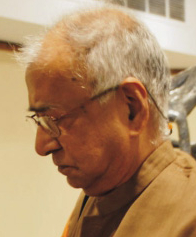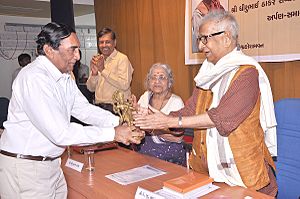K. G. Subramanyan facts for kids
Quick facts for kids
K. G. Subramanyan
|
|
|---|---|

K.G. Subramanyan 2008.
|
|
| Born | 1924 Kuthuparamba, Kerala, India
|
| Died | 29 June 2016 (aged 92) |
| Education | Visva-Bharati University |
| Alma mater | Visva-Bharati University |
| Occupation | Painter, sculptor, muralist, printmaker, writer, academic |
| Movement | Contextual Modernism, Baroda Group |
| Awards | Padma Shree, Kalidas Samman, Padma Bhushan, Padma Vibhushan |
Kalpathi Ganpathi "K.G." Subramanyan (born in 1924 – died on June 29, 2016) was a very important Indian artist. He was a painter, sculptor, and writer. He also taught art to many students. In 2012, he received the Padma Vibhushan, one of India's highest civilian awards.
Contents
Life Story of a Creative Artist
K.G. Subramanyan was born in 1924 in a place called Kuthuparamba in Kerala, India. When he was young, he first studied economics at Presidency College, Madras.
During India's fight for freedom from British Rule, he was very active. He believed in the ideas of Mahatma Gandhi, who taught peaceful protest. Because of his involvement, he was even put in prison. He was also not allowed to join government colleges.
His life changed when he decided to become an artist. In 1944, he went to Santiniketan to study art at Kala Bhavan. This was the art school of Visva Bharati University. He learned from famous Indian artists like Nandalal Bose, Benode Behari Mukherjee, and Ramkinkar Baij. He studied there until 1948.
In 1951, he started teaching art. He became a lecturer at the Faculty of Fine Arts at M.S. University in Vadodara. In 1956, he briefly studied in London at the Slade School of Art. He went there as a scholar, which means he received a special grant to study.
He returned to Baroda as a professor of painting. Later, in 1966, he spent some time in New York as a Rockefeller Fellow. This was another special program for talented people. In 1980, Subramanyan went back to Santiniketan to teach at his old art school, Kala Bhavan. He taught there until he retired in 1989. After retiring, he was made a Professor Emeritus of Visva Bharati, which is a special title for respected former professors.
In his later years, Subramanyan lived in Vadodara with his daughter, Uma. He passed away there on June 29, 2016.
Artistic Styles and Inspirations
K.G. Subramanyan's art was inspired by many different styles. He loved the folk art from his home state of Kerala. He also looked at traditional Indian paintings like Kalighat painting and Pattachitra from Bengal and Odisha. These are old styles of painting that tell stories. He also learned from Indian court paintings, which were made for kings and queens.
Special Art Shows
There have been many special art shows, called retrospectives, about K.G. Subramanyan's work. A retrospective show displays an artist's work from their whole career. The biggest one was called K.G. Subramanyan, a Retrospective. It was put together by R. Siva Kumar at the National Gallery of Modern Art.
His Career Journey
K.G. Subramanyan had a long and active career in art and education. From 1951 to 1959, he was a lecturer in painting at the Faculty of Fine Arts in Baroda. He also studied in the UK as a British Council Research Scholar from 1955 to 1956. He worked as a design expert for the All India Handloom Board in Bombay from 1959 to 1961. He then became a Reader in Painting at the Faculty of Fine Arts, Baroda, from 1961 to 1965.
From 1966 to 1980, he was a Professor of Painting at the Faculty of Fine Arts in Baroda. He also received a special fellowship from The JDR III Fund in New York from 1966 to 1967. He was the Dean of the Faculty of Fine Arts in Baroda from 1968 to 1974.
In 1975, he was chosen to be part of the World Crafts Council. He also visited Canadian universities as a guest lecturer in 1976. From 1977 to 1978, he was a Visiting Fellow at Kala Bhavan in Santiniketan.
He returned to Santiniketan as a Professor of Painting from 1980 to 1989. In 1985, he was a guest of the Chinese Artists Association in China. From 1987 to 1988, he was a Christensen Fellow at St. Catherine’s College, Oxford. After retiring in 1989, he became a Professor Emeritus at Kala Bhavan. In 2004, he moved back to Baroda.
Awards and Recognitions

K.G. Subramanyan received many important awards for his contributions to art:
- 1963: He received an Honourable Mention at the Sao Paulo Biennale in Brazil.
- 1965: He won the National Award from the Lalit Kala Akademi.
- 1968: He was awarded a Gold Medal at The First International Triennale in New Delhi.
- 1975: The Government of India honored him with the Padma Shri.
- 1991: He received the Gagan-Aban Puraskar from Visva-Bharati University.
- 1992: He was given an honorary D.Litt. degree (Doctor of Letters) by Rabindra Bharati University.
- 2006: The Government of India awarded him the Padma Bhushan.
- 2009: He received the Dishikottam from Visva-Bharati University.
- 2011: He was awarded another honorary D.Litt. degree by Assam University.
- 2012: He received the Padma Vibhushan, one of India's highest civilian awards.
- 2015: He was given the Dhirubhai Thakar Savyasachi Saraswat Award.
Memberships and Groups
K.G. Subramanyan was part of many important art and design groups. He was a member of the All India Board of Technical Studies in Applied Art from 1961 to 1967. He was also involved with the Gujarat Lalit Kala Akademi and the main Lalit Kala Akademi for many years. He served on the Governing Council of the National Institute of Design in Ahmedabad. He was also a member of the All India Handloom and Handicrafts Board.
Books Written by Him
K.G. Subramanyan was also a talented writer. He wrote several books about art and culture:
- 1978: Moving Focus: Essays on Indian Art
- 1987: The Living Tradition
- 1992: The Creative Circuit
- 2006: He translated Benodebehari Mukherjee’s book Chitrakar.
- 2007: Poems
- 2007: The Magic of Making: Essays on Art and Culture
Books He Illustrated
He also illustrated many books, especially for children:
- 1969: When God First Made the Animals He Made Them All Alike
- 1972: The Butterfly and the Cricket, A Summer Story, Robby
- 1974: Our Friends the Ogres, The King and the Little Man
- 1979: How Poppy Grew happy, Cat’s Night and Day, Frog Life is Fun Life
- 1985: Of Ogres Beasts and Men (a collection of earlier stories)
- 1995: How Hanu Became Hanuman, Death in Eden, In the Zoo
- 1998: The Tale of the Talking Face
Famous Murals
K.G. Subramanyan created many large wall paintings, known as murals:
- 1955: Murals at Jyoti Ltd. and Faculty of Fine Arts in Baroda.
- 1963: A mural called ‘King of the Dark Chamber’ in Lucknow.
- 1965: A mural for the India Pavilion at the New York World Fair.
- 1969: A mural for the ‘India of my Dreams Pavilion’ in New Delhi.
- 1976: A mural at the R & D Building, Jyoti Pvt. Ltd., Baroda.
- 1988: A sand cast cement mural at Kala Bhavan, Santiniketan.
- 1989: A special reverse painting on glass mural, made with school children, in Santiniketan.
- 1990: A black and white mural at Kala Bhavana, Santiniketan (first part).
- 1993: The second part of the black and white mural at Kala Bhavana.
- 2009: A second version of the black and white mural at Kala Bhavana.
His Students
K.G. Subramanyan taught and inspired many artists who became famous in their own right. Some of his notable students include:
- Bhupen Khakhar
- Ghulam Rasool Santosh
- Gulam Mohammed Sheikh
- Haku Shah
- Jayant Parikh
- Jyoti Bhatt
- Jyotsna Bhatt
- Laxma Goud
- Mrinalini Mukherjee
- Nilima Sheikh
- Rajeev Lochan
- Ratan Parimoo
- Rekha Rodwittiya
- Shanti Dave
- Thota Vaikuntam
- Vivan Sundaram

